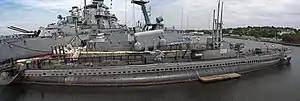.jpg.webp) USS Lionfish | |
| History | |
|---|---|
| Name | Lionfish |
| Namesake | Lionfish |
| Builder | |
| Yard number | 553 |
| Laid down | 15 December 1942[1] |
| Launched | 7 November 1943[1] |
| Sponsored by | Mrs. Harold C. Train |
| Commissioned | 1 November 1944[1] |
| Decommissioned | 16 January 1946[1] |
| Recommissioned | 31 January 1951[1] |
| Decommissioned | 15 December 1953[1] |
| Stricken | 20 December 1971[1] |
| Status | Museum ship at Battleship Cove, Fall River, Massachusetts since 30 August 1972[2] |
| General characteristics | |
| Class and type | Balao-class submarine[2] |
| Displacement | |
| Length | 311 ft 6 in (94.95 m)[2] |
| Beam | 27 ft 3 in (8.31 m)[2] |
| Draft | 16 ft 10 in (5.13 m) maximum[2] |
| Propulsion |
|
| Speed | |
| Range | 11,000 nmi (20,000 km; 13,000 mi) surfaced at 10 knots (19 km/h; 12 mph)[6] |
| Endurance |
|
| Test depth | 400 ft (120 m)[6] |
| Complement | 10 officers, 70–71 enlisted[6] |
| Armament |
|
USS Lionfish (SS-298) | |
 | |
| Location | Fall River, Massachusetts |
| Coordinates | 41°42′22″N 71°09′47″W / 41.70611°N 71.16306°W |
| Built | 1943 |
| NRHP reference No. | 76002270[7] |
| Significant dates | |
| Added to NRHP | 30 September 1976 |
| Designated NHL | 14 January 1986 |
USS Lionfish (SS-298), a Balao-class submarine, was the only ship of the United States Navy named for the lionfish, a scorpaenid fish native to the Pacific and an invasive species found around the Caribbean. She was designated a National Historic Landmark in 1986, and is now on display at Battleship Cove in Fall River, Massachusetts.
Construction and commissioning
Lionfish was laid down on 15 December 1942; launched on 7 November 1943, sponsored by Mrs. May Philipps Train, wife of Rear Admiral Harold C. Train; and commissioned on 1 November 1944. Her first commanding officer was Lieutenant Commander Edward D. Spruance, son of World War II admiral Raymond Spruance.
World War II
After completing her shakedown cruise off New England, she began her first war patrol in Japanese waters on 1 April 1945. Ten days later, she avoided two torpedoes fired by a Japanese submarine. On 1 May, Lionfish destroyed a Japanese schooner with her deck guns. After a rendezvous with the submarine USS Ray (SS-271), she transported United States Army Air Forces B-29 Superfortress survivors to Saipan in the Mariana Islands and then made her way to Midway Atoll in the Northwestern Hawaiian Islands for replenishment.
On 2 June 1945 she started her second war patrol, and on 10 July 1945 fired torpedoes at a surfaced Japanese submarine I-162, after which Lionfish's crew heard explosions and observed smoke through their periscope, although I-162 was undamaged. She subsequently fired on two more Japanese submarines. Lionfish ended her second and last war patrol performing lifeguard duty (the rescue of downed fliers) off the coast of Japan. When World War II ended on 15 August 1945, she headed for San Francisco, California, and was decommissioned at Mare Island Navy Yard in Vallejo, California, on 16 January 1946.
Post World War II
Lionfish was recommissioned on 31 January 1951, and headed for the United States East Coast for training cruises. After participating in NATO exercises and a Mediterranean cruise, she returned to the East Coast and was decommissioned at the Boston Navy Yard on 15 December 1953.
In 1960, the submarine was placed in service, but not recommissioned, as a reserve training submarine at Providence, Rhode Island.
Museum ship

In 1971, she was stricken from the Navy Register. In 1973, she began permanent display as a memorial at Battleship Cove in Fall River, Massachusetts, where she is one of the museum's most popular exhibits.
As Lionfish was never converted to a GUPPY configuration, she is one of the very few preserved American World War II-era submarines in her "as built" configuration. Because of this state of preservation, she was designated a National Historic Landmark in 1986.[8]
In popular culture
The submarine is featured on the DVD case of the 2007 Ubisoft game Silent Hunter 4: Wolves of the Pacific.
The submarine was also featured in the 2015 movie drama Subconscious.
Awards
- Asiatic-Pacific Campaign Medal with one battle star
- World War II Victory Medal
- Navy Occupation Medal with "EUROPE" clasp
- National Defense Service Medal
See also
Citations
- 1 2 3 4 5 6 7 8 Friedman, Norman (1995). U.S. Submarines Through 1945: An Illustrated Design History. Annapolis, Maryland: United States Naval Institute. pp. 285–304. ISBN 1-55750-263-3.
- 1 2 3 4 5 6 7 Bauer, K. Jack; Roberts, Stephen S. (1991). Register of Ships of the U.S. Navy, 1775-1990: Major Combatants. Westport, Connecticut: Greenwood Press. pp. 275–280. ISBN 0-313-26202-0.
- 1 2 3 4 5 Bauer, K. Jack; Roberts, Stephen S. (1991). Register of Ships of the U.S. Navy, 1775–1990: Major Combatants. Westport, Connecticut: Greenwood Press. pp. 270–280. ISBN 978-0-313-26202-9.
- ↑ U.S. Submarines Through 1945 pp. 261–263
- 1 2 3 U.S. Submarines Through 1945 pp. 305–311
- 1 2 3 4 5 6 U.S. Submarines Through 1945 pp. 305–311
- ↑ "National Register Information System". National Register of Historic Places. National Park Service. 15 April 2008.
- ↑ "MACRIS inventory record and NRHP nomination for USS Lionfish". Commonwealth of Massachusetts. Retrieved 25 February 2015.
References
- "National Register of Historic Places Nomination Form – Accompanying Photos". National Park Service. Retrieved 5 October 2012.
External links
- Battleship Cove
- USS Lionfish Photos on board the Submarine USS Lionfish SS-298 in Fall River, MA
- Subconscious (2015) - an independent film featuring the actual USS Lionfish as the on location filming set.
- USS Lionfish at Historic Naval Ships Association
